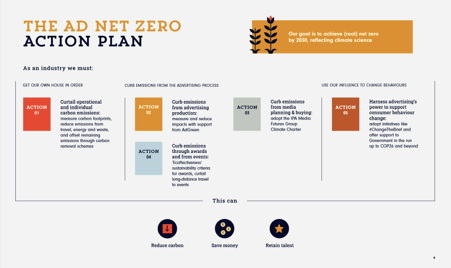This week marks the launch of the Advertising Association (AA) and Credos’ Ad Net Zero report [1], the biggest step so far towards coordinating a collective response from the UK ad industry to the climate emergency.

The report sets out a five point action plan for the entire industry, from creative and media agencies to media owners, to help the development, production and media placement of advertising achieve real net zero by 2030.
Action Point 3, curbing the emissions from media planning and buying, is incredibly pertinent for media agencies, Rapport and the wider OOH industry. Indeed, significant and comprehensive action in this space will be key to reaching the net zero target by 2030.
So, what action will be needed to curb media emissions and what is already being done across the OOH industry?
From a wider media industry perspective, one of the key recommendations within Action Point 3 is the adoption of the IPA Media Futures Group Climate Charter. Providing the tools and resources to support the transition to a zero carbon future, the charter seeks to enable media planning and buying choices to be made with their carbon emissions impact front of mind.
The charter also aims to help agencies of all sizes address Action Point 1; “getting our own house in order”, through the provision of advice and best-practice examples from across the industry to aid in the reduction of operational emissions.
We at Rapport – representing ourselves and IPG Mediabrands – are proud to be one of the founding members and contributors to the charter, having developed it through our role on the AA’s Media Agency Climate Action Group alongside Mindshare, Mediacom, the7stars, Manning Gottlieb and PHD Media, and are both excited and hopeful of its adoption across the entire media agency landscape.
What Does This Mean For OOH?
OOH is a unique medium. Unlike other media that are embedded within, and that partly fund, content consciously selected by an end-consumer (e.g. TV, Radio, Press and Digital), responsibility for an OOH campaign’s environmental impact lies almost exclusively with advertisers and the advertising industry. This is not limited to just OOH media owners, but arguably also specialist agencies such as ourselves, landlords and other OOH-affiliated businesses.
For many years, OOH media owners have been actively recognising and addressing this responsibility from an emissions perspective, transitioning to more efficient and less environmentally impactful products and operations. This coincides with the prevailing direction of change in the industry, in which traditional poster sites are increasingly converted to digital screens (DOOH), requiring no physical production or distribution of advertising.
In line with Action Point 3, OOH media owners – including Clear Channel, Global and JCDecaux have already transitioned to, or are in the process of transitioning to, 100% renewable energy across their advertising estate by the end of 2020.
Beyond this, significant and consistent investment has been made by the industry to improve the energy efficiency of new and existing DOOH screens, as well as more efficient lighting for remaining classic OOH inventory.
Going Beyond
At Rapport we are passionate about the environment. We launched our ‘Beyond’ platform two months ago, with the aim of recognising and addressing our environmental responsibility and encouraging positive change across the industry.
We know that the responsibility for media emissions is a complicated and pressing issue, and although it is imperative that media owners continue their transition to less carbon intensive products in order to fulfil the ambitions of Ad Net Zero and the industry, we also recognise our own responsibility as part of the OOH ecosystem.
To demonstrate this, we created a DOOH carbon calculator and began tracking the actual emissions generated from our clients’ DOOH campaigns through our verification platform Rapportal. We have already offset our DOOH emissions for the first half of 2020 on behalf of our clients and will continue to do so.
By complementing the OOH industry’s transition to renewable energy, the hope is that our DOOH activity will eventually lead to negative emissions.
Minimising operational emissions as much as possible is also crucial if the ad industry wants to reach its real net zero target by 2030. In line with the AA’s recommendations, we have already set up the Beyond Environmental taskforce, who will lead our internal drive towards the minimisation of operational emissions and our own target of being carbon neutral by 2021 and Climate Negative the following year.
We’d love to hear from anyone in the OOH industry, or beyond (pun intended), that would like information about our DOOH carbon calculator, or else is passionate about supporting our collective drive to achieve Ad Net Zero for the OOH industry.
To paraphrase Keith Weed from the AA’s launch, it’s a case of “all for none, none for OOH”.
Jack Monaghan is Insight Manager at Rapport. You can reach him at
Jack.Monaghan@rapportww.com, he’d love to hear from you.